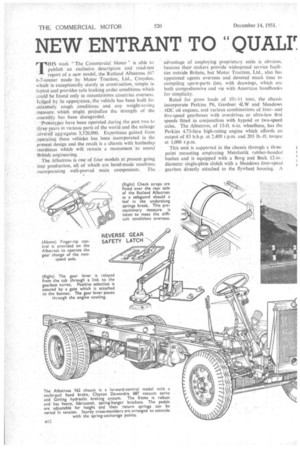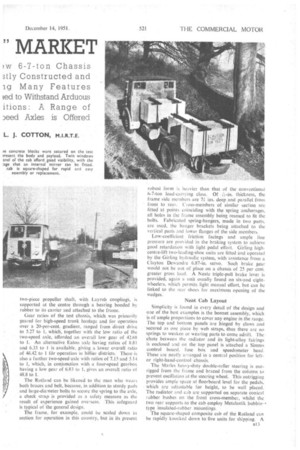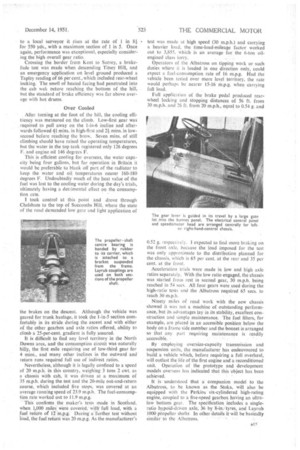NEW ENTRANT TO " QUALIF "MARKET
Page 46

Page 47

Page 48

Page 49

If you've noticed an error in this article please click here to report it so we can fix it.
6-7-ton Chassis 3t1y Constructed and ig Many Features ied to Withstand Arduous itions: A Range of Deed Axles is Offered L. .1. COTTON, M.I.R.T.E. THIS week "The Commercial. Motor" is able to publish an exclusive description and road-test . . report of a new model, the Rutland Albatross 162 6-7-tonner made by Motor Traction, Ltd., Croydon. . Which is exceptionally sturdy in construction, simple in layout and providessafe braking under conditions which .could be found only in mountainous countries overseas. fudged by its appearance, the vehicle has been built for . extremely rough conditions and any weight-saving ;measure:. which might prejudice the strength of the assembly has been disregarded.
.PrototyPes have been operated during the past two to three years in various parts of the world and the mileage ,covered aggregates 3,520,000. Experience gained from , operating these vehicles has been incorporated in the present design and the result is a chassis with battleship :sturdiness -which will remain a monument to sound British engineering.
The Albatross is one of four models at present going into production, all of which are hand-made machines -incorporating well-proved main components. The • advantage of employing proprietary units is obvious, because their makers provide widespread service facilities outside Britain, but Motor Traction, Ltd., also has appointed agents overseas and devoted 'much time to compiling spare-parts lists, with drawings, which are both comprehensive and vie with American handbooks for simplicity.
Rated for gross loads of 102,-11 tons, the chassis incorporate Perkins P6, Gardner 4LW and Meadows 4IDC oil engines, and various combinations of fourand five-speed gearboxes with overdrives or ultra-low first speeds fitted in conjunction with hypoid or two-speed axles. The Albatross, of I3-ft. 6-in, wheelbase, has the Perkins 4.73-litre high-rating engine which affords an output of 83 b.h.p. at 2,400 r.p.m. and 203 lb.-ft. torque at 1,000 r.p.m.
This unit is supported in the chassis through a threepoint mounting employing Metalastik rubber-bonded bushes and is equipped with a Borg and Beck 12-in.diameter single-plate clutch with a Meadows four-speed gearbox directly attached to the flywheel housing. A two-piece propeller shaft, with Layrub coupling's, is supported at the centre through a bearing bonded by rubber to its carrier and attached to the frame.
Gear ratios of the test chassis, which was primarily geared for high-speed trunk haulage and for operation over a 20-per-cent. gradient, ranged from direct drive to 5.27 to 1, which, together with the low ratio of the .two-speed axle, afforded an Overall low gear of 42.68 to. -I. An alternative Eaton axle having ratios of 8.81 and 6.33 to 1 is available, giving a lower overall ratio of 46.42 to 1 Or operation in hillier districts. There is also a further two-speed axle with ratios of 7.15 and 5.14 to I, which, in conjunction with a four-speed. gearbox having a low gear of 683 to 1, gives an overall ratio of 48.8 to 1.
• The Rutland can be likened to the man who wears both braces and belt, because, in addition to sturdy pads and large-diameter bolts to secure the spring to the axle, a check strap is provided as asafety measure as the result of experience gained overseas. This safeguard is typical of the generardesign.
The frame, for example, could •be. scaled down in section for operation in this country, but in its present robust form is heavier than that of the conventional
6-7-ton load-carrying class. Of thickness, the frame side members are 7: ins, deep and parallel from front to rear. Cross-members Of Similar section are fitted at points coinciding with the spring anchorages, all holes in the frame assembly being reamed to fit the bolts. Fabricated spring-hangers, Made in two parts, are used, the hanger brackets being attached to the vertical parts and lower flanges of the side members.
Low-coefficient friction facings and ample line pressure are provided in the braking system to achieve good retardation with light • pedal effort. Girling highcentre-lift two-leading-shoe units are fitted and Operated by the Girling hydraulic system, with assistance from a Clayton Dcwandre 6.87-in. servo, . Such brake .gear would not be out of place on a chassis of 25 per cent. greater gross load. A Neate triple.:pull brake lever is provided, again a unit usually found on six-and eightwheelers, which permits light manual effort, but can be linked to the i.ear shoes for maximum opening of the wedges.
Neat Cab Layout Simplicity is found in every detail of the design and one of the best examples is the bonnet assembly, which is of ample proportions to cover any engine in the range. The top and bottom panels are hinged by •claws and secured as one piece by web straps,thus there are no springs to weaken or wearing parts to come. adrift. The chute between the radiator and its light-alloy fairings is enclosed and on the top panel is attached a Simms control board, fuse box and .speedometer head. These are neatly arranged in a central position for leftor right-hand-control chassis.
The Marles heavy-duty double-roller steering is outrigged from the frame and braced from the column to prevent oscillation at the steering wheel. This outrigging provides ample space at floorboard level for the pedals, which are adjustable for height, to be well placed. The radiator and cab are supported on -separate conical rubber bushes on the front cross-member, whilst the two rear supports 4o the cab employ Metalastik bobbin• type insulated-rubber mountings. •
The square-shaped composite cab of the Rutland can be rapidly knocked down to-five units for shipping. A 1 3 special ant-proof timber, o pepe, is used for cabs destined for the tropics. Because all the cabs are figbuilt, a section can be exchanged by unskilled labour; the window panels are also made for easy replacement.
The Albatross chassis provided for test, carried massive re-inforced-concrete blocks totalling almost 7 tons, representing body and payload. Without heed to the high overall gear ratio, I decided to treat the Rutland to a thorough trial on the North Downs and within a few minutes of leaving Croydon it was tackling Shirley Hill, where I was impressed by its performance.
Normally, the axle speed shift is attached to the gear lever, but on the Albatross the change in axle ratio is effected by depressing or raising a linger-tip lever below the steering wheel. The driver soon demonstrated the advantage of axle-gearbox combination by preselecting high ratio on the axle and jointly moving the gear lever from third-low to second-high. , The gear lever projects through the bonnet and there is no doubt about its position in each gear, because it is provided with a visual gate. It has a fairly short movement and I found it most comfortable to operate.
With the close-ratio gearbox and a two-speed axle providing half-steps between, the engine is kept working hard. Whenever the engine speed starts falling on inclines, the next half-ratio is selected and with a sharp dab on the clutch pedal, or by momentarily releasing presstite on the accelerator, the change is completed.. The short run down Gravel Hill was accomplished at well over 40 m.p.h., and within a short while the Albatross was undergoing manceuvrability trials along Layharns Farm Road, a narrow winding thoroughfare with many sharp turns. The slightest defect or trace of steering-wander would be shown up on such a surface as the steeply cambered and heavily rutted road between the farms, but there was no evidence of potential steering difficulties.
. Salt Box Hill was the next objective and Was descended from Addington with low-third gear engaged and the brakes lightly applied. With a clear road ahead, the approach from the valley to Biggin Hill was made with a flying start, but three rapid gear changes were soon required.
On approaching ihe 1-in-7 section there was still a half-ratio left for emergency and this was required after stopping on the gradient. Running temperatures were low after climbing in bottom gear for half a mile and with an ambient reading of 38 degrees F., the tOp watertank temperature was a mere 118 degrees F. There is no thermostat in the cooling system. .
After turning at Biggin Hill, we retraced the course down into the valley. Without warning, the driver applied the brakes to check their efficiency on the slope and I was shot smart/Y out of my Seat .
Climbing the Addington side from the valley, the hill is sharper over a shorter distance and according
to a local surveyor it rises at the rate of 1 in 8i for 550 yds., with a maximum. section of 1 in 5. Once again, performance was exceptional, especially considering the high overall gear ratio.
Crossing the border from Kent to Surrey, a brakefade test was made when descending Titsey Hill, and an emergency application on level ground produced a Tapley reading of 66 per cent., which included rear-wheel locking. The smell of heated facing had penetrated into the cab well before reaching the bottom of the hill, but the standard of brake efficiency was far above average with hot drums.
Over Cooled
After turning at the foot of the hill, the cooling effiriency was measured on the climb. Low-first gear was . required to pull away on the 1-in-6 incline and afterwards followed 41mins. in high-first and 21 mins. in lowsecond before reaching the brow. Seven mins. of stiff climbing should have raised the operating temperatures, but the water in the top tank registered only 126 degrees F. and engine oil 146 degrees F.
This is efficient cooling for overseas, the water capacity being four gallons, but for operation in Britain it would be preferable to blank off part of the radiator to keep the water and oil temperatures nearer 160-180 degrees F. Undoubtedly much of the heat value of the fuel was lost to the cooling water during the day's trials, ultimately having a detrimental effect on the consumption rate.
I took control at this point and drove through Chelsham to the top of Succombs Hill, where the state of the road demanded low gear and light application of the brakes on the descent. Although the vehicle was geared for trunk haulage, it took the 1-in-5 section comfortably in its stride during the ascent and with either of the other gearbox and axle ratios offered, ability to climb a 25-per-cent. gradient is fully assured.
It is difficult to find any level territory in the North Downs area, and the consumption circuit was .naturally hilly, the first mile requiring use of low-third gear for 4 mins., and many other inclines in the outward and return runs required full use of iadirect ratios.
Nevertheless, although it is legally confined to a speed of 20 m.p.h. in this coantry, weighing 3 tons 2 cwt. as a chassis With cab, it was driven at a maximum of 35 M.p.h. during the test and the 20-mile out-and-return course, which included five stops, was covered at an average rimnifig speed of 23.9 mph. The fuel-consumption rate Worked out to 11.9 m.p.g. This confirnis the maker's tests made in Scotiand, when 1,000 mileS. Were covered, with full load, with a fuel return d 12 mpg During a: further test without toad, the fuelreturii was 20 m.p.g. As the manufacturer's
test was made at high speed (30 m.p.h.) and carrying a heavier load, the time-load-mileage factor worked out to 3,855. which is an average for the 6-ton oilengined class lorry.
Operators of the Albatross on tipping work or such duties where it is loaded in one direction only, could expect a fuel-consumption rate of 16 m.p.g. Had the vehicle been tested over more level territory, the rate would perhaps be nearer 15-16 m.p.g. when carrying full load.
Full application of the brake pedal produced rearwheel. locking and stopping distances of 56 ft. from 30 m.p.h. and 26 ft. from 20 m.p.h., equal to 0.54 g. and
0.52 g. respeetk ci v. I expected to find more braking on the front axle, because the load imposed for the test was only approximate to the distribution planned for
the chassis, which is 65 per cent. at the rear and 35 per cent, at the front.
Acceleration trials were made in low and high axle ratios separately. With the low ratio engaged, the chassis was started from rest in second gear, 30 m.p.h. being reached in 54 sees. All four gears were used during the high-ratio tests and the Albatross required 65 secs. to reach 30 m.p.h.
Ninety miles of road work with the new chassis showed it was not a machine of outstanding perform ance, but its advantages lay in its stability, excellent construction and simple maintenance. The fuel filters, for example, are placed in an accessible position below the body on a frame side member and the bonnet is arranged so that any part requiring maintenance is readily accessible.
By employing oversize-capacity transmission and suspension units, the manufacturer has endeavoured to build a vehicle which, before requiring a full overhaul, will outlast the life of the first engine and a reconditioned unit. Operation of the prototype and development models overseas has indicated that this object has been achieved. • It is understood that a: companion model to the Albatross, to be known as the Stuka, will also be equipped with the Perkins • six-cylindered high-rating engine, coupled to a five-speed gearbox having an ultralbw bottom gear. The specification includes a single
ratio hypoid-driven axle; a6 by 8-in.:tyres, and Layrub 100() propeller shafts In other. 'details it will be basically
similar to the Albatross. ..• • ,




























































































